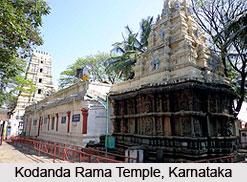 Kodanda Rama Temple, also known as `Kodandaramaswami Temple` is amongst the renowned monuments of Hampi and a famous UNESCO World Heritage Site, dedicated to the Hindu deity, Lord Rama. It is located in Chikkamagaluru District in Karnataka, close to the historical site of Hampi, and is revered more as a religious structure, rather than as an architectural marvel. Lord Rama is the presiding deity of this temple, who is depicted standing at the sanctum sanctorum, equipped with arrows, along with his wife Sita on his right and his brother Lakshmana towards his left. The idols were composed of a single natural, gigantic stone, and the temple is based near Tungabhadra River. The sacred bathing ghat of `Chakratirtha` is situated in front of the Kodanda Rama Temple.
Kodanda Rama Temple, also known as `Kodandaramaswami Temple` is amongst the renowned monuments of Hampi and a famous UNESCO World Heritage Site, dedicated to the Hindu deity, Lord Rama. It is located in Chikkamagaluru District in Karnataka, close to the historical site of Hampi, and is revered more as a religious structure, rather than as an architectural marvel. Lord Rama is the presiding deity of this temple, who is depicted standing at the sanctum sanctorum, equipped with arrows, along with his wife Sita on his right and his brother Lakshmana towards his left. The idols were composed of a single natural, gigantic stone, and the temple is based near Tungabhadra River. The sacred bathing ghat of `Chakratirtha` is situated in front of the Kodanda Rama Temple.
Legend Kodanda Rama Temple
Regional mythical tales state that Kodanda Rama Temple is based on the exact spot wherein Lord Rama had killed `Bali` prior to the crowning of `Sugriva` as the new ruler of the kingdom of `Kishkhinda`. It is said that the statues of Rama, Lakshmana and Sita were carved out from a single rock boulder by Sugriva, as he wished the deities to be worshipped at this temple. Therefore it is believed that the temple is existent here since the era of Ramayana. Other legendary accounts claim that the region was the habitat of nine `siddhas` who had performed penance close to a pond in `Siddha Pushkarni`, which was also the residence of the saint `Parashurama`, which is the reason why it is also known as `Bhargavapuri` or `town of Bhargava`.
However, as per `Sthalapurana`, Purushottama was defeated by Lord Rama at Hiremagalur, after which he requested Him to demonstrate the scene of His marriage to Sita. Hearing this, Sita stood by the right side of Rama while Lakshmana stood by his left, according the traditions in Hindu wedding ceremonies.
Architecture of Kodanda Rama Temple
Kodanda Rama Temple is protected by the State Government of Karnataka and seems to have been constructed in three distinct stages and its `sukhansi` structures and `garbhagriha` are created in Hoysala style. The other structures are accomplished as per the Dravidian architecture or southern Indian style of architecture. The `mukhamandapa` belongs to the 16th century and the current `navaranga` is of the 14th century. Six cornices are a portion of the vestibule and the garbhagriha, both present on a high platform. Mortar and brick are employed to create the mukhamandapa and navaranga.
There exists a Hanuman pedestal inside the sanctum sanctorum measuring about 1.5 feet in height, and the idols of the Hindu deities can be traced to a much earlier date, earlier than the period of the Hoysalas. Tiny shrines of Vedanta Desika, Mardhana, Madhvacharya, Kalinga, Ramanujacharya, Sugriva and Yoganarasimha are existent in the enclosure or `prakara` of the temple. The idol of Yoganarasimha is about 1.06 metres in height. Statues of Lord Krishna and Balarama are also embedded. There are two rows of holy figures portraying Lord Vishnu and His divine incarnations, on the exterior walls of the garbhagriha and also the `sukansi`, apart from pilasters. The idols of Lord Ganapati, Garuda, Goddess Lakshmi and Hanuman are also existent in Kodanda Rama Temple. During the period from February till March, a special `Yatra` is organised in Kodanda Rama Temple, for one day.











